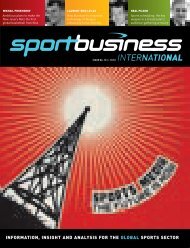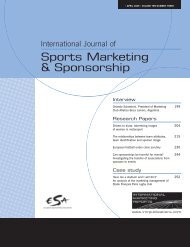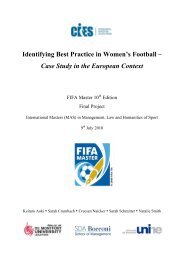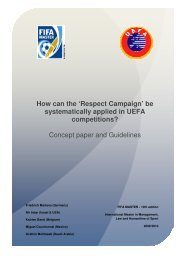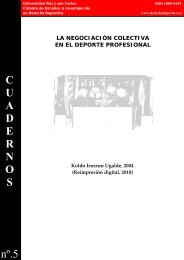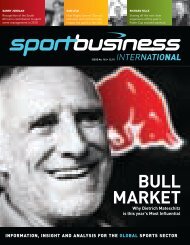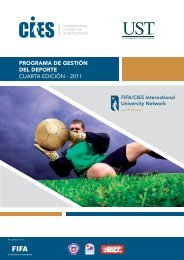Sports Marketing & Sponsorship - FIFA/CIES International University ...
Sports Marketing & Sponsorship - FIFA/CIES International University ...
Sports Marketing & Sponsorship - FIFA/CIES International University ...
- No tags were found...
Create successful ePaper yourself
Turn your PDF publications into a flip-book with our unique Google optimized e-Paper software.
Sustaining the raceRESEARCH PAPERdimensions of environmental change; an outlook forthe future using four possible scenarios up to the year2050, according to: a) Markets First; b) Policy First; c)Security First; and d) Sustainability First.GEO-4 draws the general conclusion that, despitesome progress, across the globe we are a long wayfrom achieving environmental sustainability. On thecontrary, in the words of the GEO-4 authors, “there isevidence of unprecedented environmental change atglobal and regional levels”. These include:• warming of the Earth’s surface, evident fromobservations of increases in global average air andocean temperatures, widespread melting of snowand ice, and rising global average sea level (UnitedNations Environment Programme, 2007b, p.72).While the global average temperature increased by0.74°C in the 20th century, the IPCC estimatefurther warming during the 21st century to bebetween 1.8 to 4.0°C.• More than 2 million people globally dieprematurely every year due to outdoor and indoorair pollution (United Nations EnvironmentProgramme, 2007b, p.72).• The ‘hole’ in the stratospheric ozone layer over theAntarctic – the layer that protects people fromharmful ultraviolet radiation – is now the largest ithas ever been (United Nations EnvironmentProgramme, 2007b, p.73). The ozone layer isexpected to recover, but not until between 2060and 2075 as a result of long lag times.• Unsustainable land use and climate change aredriving land degradation, including soil erosion,nutrient depletion, water scarcity, salinity,desertification, and the disruption of biologicalcycles (United Nations Environment Programme,2007b, p.72).• The per capita availability of freshwater is decliningglobally, and contaminated water remains thegreatest single environmental cause of humansickness and death (United Nations EnvironmentProgramme, 2007b, p.183).• If present trends continue, 1.8 billion people willbe living in countries or regions with absolutewater scarcity by 2025, and two-thirds of thepeople in the world could be subject to waterstress (United Nations Environment Programme,2007b, p.129).• Although the decline in the area of temperate foresthas been reversed, with an annual increase of30,000 km 2 between 1990 and 2005,deforestation in the tropics continued at an annualrate of 130,000 km 2 during the same period.More than 16, 000 species have been identifiedas threatened with extinction (United NationsEnvironment Programme, 2007b, p.114).According to GEO-4, these changes are mostly due tohuman activities in an “increasingly globalised,industrialised and interconnected world, driven byexpanding flows of goods, services, capital, people,technologies, information, ideas and labour”. However,the responsibility for global environmental pressureslies mainly with industrialised countries where “20 percent of world population produced 57 per cent ofgross world product”, and “accounted for 46 per centof greenhouse gas emissions”(United NationsEnvironment Programme, 2007a, p.4). This linkbetween globalisation, industrialisation andenvironmental damage, particularly in advancedeconomies, in turn highlights the role that materialconsumption plays in processes of adverseenvironmental change. This is of direct relevance tomotorsport, because although its contribution toenvironmental problems has not been quantified,motorsport governance, research, design,manufacturing and competition emerge almost entirelyfrom these same industrialised countries.Alarmingly, the report also finds that biophysical andsocial systems are vulnerable to reaching ‘tippingpoints’, beyond which there may be “abrupt,accelerating, or potentially irreversible changes” (p.5).The four GEO-4 scenarios show an increasing risk ofcrossing tipping points, even as some “globalenvironmental degradation trends are slowed or86 <strong>International</strong> Journal of <strong>Sports</strong> <strong>Marketing</strong> & <strong>Sponsorship</strong> ● OCTOBER 2009 ●



